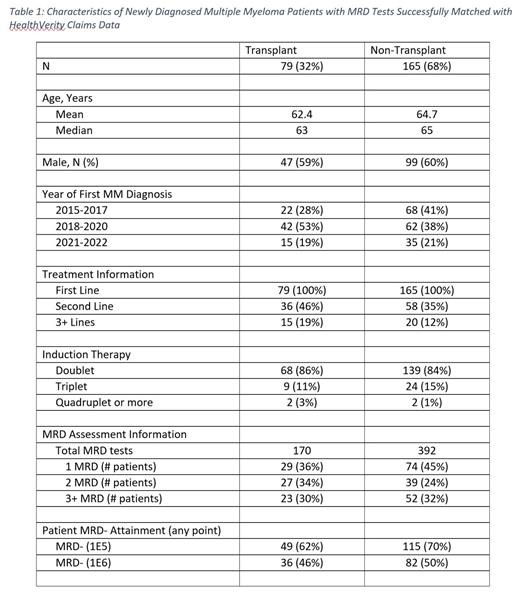Introduction
The depth of response in multiple myeloma (MM) after therapy is closely related to the prognosis of the disease. Robust data supports minimal residual disease (MRD) as prognostic after induction, auto-SCT, consolidation; during maintenance therapy; and in the R/R treatment setting. MRD is also prognostic despite unfavorable cytogenetics or transplant eligibility. Accordingly, clinical practice guidelines recommend the assessment of MRD after each phase of treatment, and MRD negativity is increasingly considered an important treatment goal. However, understanding how MRD is currently utilized in routine clinical practice across institutional and community settings is challenging. We have adopted an existing claims-based algorithm and linked MRD test results to explore assessment patterns and attainment of MRD negativity across lines of treatment and patient transplant status in the real-world setting.
Methods
The study uses Adaptive's internal MRD data linked with HealthVerity closed payer claims data through privacy-preserving record linkage (PPRL) tokenization. PPRL allows for private patient records across different data sources to be linked and shared without transmitting protected health information (PHI). The data source used is Source 20 from the Healthverity Marketplace, representing the largest available source of closed medical and pharmacy claims from health insurers. The data covers 120 million total individuals from over 120 unique payers including commercial, Medicare, and Medicaid, providing a comprehensive treatment journey of the patients. Newly diagnosed MM patients (NDMM) were identified as adults with a diagnosis of MM between January 2015 and December 2022 (the first observed MM diagnosis as Index Diagnosis), with continuous Medical and Pharmacy coverage at least 6 months during pre-index and 12 months during post-index periods. Patients were further required to have initiated MM treatment within 60 days of Index Diagnosis, had at least one MRD assessment using NGS MRD (clonoSEQ® Assay - Adaptive Biotechnologies), and no enrollment in clinical trials nor prior MM treatment pre-index. Lines of therapy were identified following an established algorithm (Fonseca, 2020). We describe patient characteristics, treatment journey, and assessment of MRD test results at a sensitivity of 10 -5 in accordance with IMWG guidance.
Results
The study identified 244 NDMM patients meeting the above criteria, of which 79 received transplant. Median age was 63 for transplant patients and 65 for non-transplant patients, 60% of all patients were male, and 80% were diagnosed before 2021. The percentage moving to next treatment was greater for transplant patients compared to non-transplant patients (2L: 46%, 3+ line: 19% vs. 2L: 35%, 3+ line: 12%). In both cohorts, front-line therapy usually consisted of an IMiD + dex doublet. For transplant patients, 62% and 46% achieved MRD- at some point during treatment at 10 -5 and 10 -6 thresholds, respectively. Similar MRD- attainment was seen in the non-transplant group (70% and 50%). A total of 562 MRD assessments were performed for these cohorts with a mean of ~2 per patient. The number of patients with >=2 MRD was 50 (63.3%) for transplant, and 91 (55.2%) for non-transplant. Among transplant patients, 88.8% of the MRD tests were performed post-transplant. Among non-transplant patients, 92.9% of the MRD tests were performed on 2L or later.
Conclusion
This analysis allows us to understand attainment of MRD negativity by transplant status and line of treatment in the real-world setting. Additional data sources are required to confirm outcomes. This study represents the first effort to enrich MRD test results with external claims data sources though tokenized linkage and provides additional patient treatment journey information as identified by the claims data.
Disclosures
Jiang:Adaptive Biotechnologies: Current Employment, Current equity holder in publicly-traded company. Hewitt:Adaptive Biotechnologies: Current Employment, Current equity holder in publicly-traded company. Simmons:Adaptive Biotechnologies: Current Employment, Current equity holder in publicly-traded company.


This feature is available to Subscribers Only
Sign In or Create an Account Close Modal